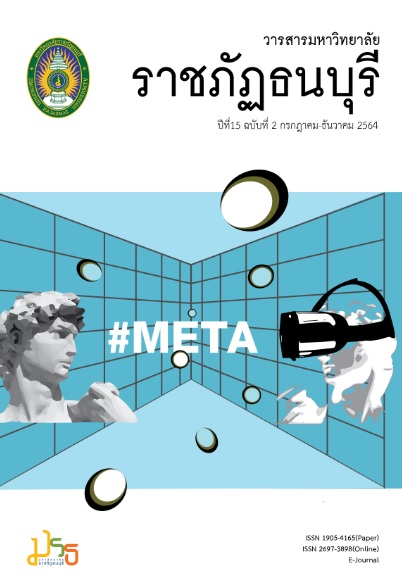Developing a Reading Instructional Model for Business English Course Based on Need Analysis
คำสำคัญ:
need analysis, Business English, reading comprehensionบทคัดย่อ
The purposes of the study were to: 1) reveal problems found in English reading comprehension, 2) explore Business English topics that learners are interested in reading comprehension, 3) discover types of learning activities that learners are interested in, and 4) survey the need for the development in reading comprehension. Participants were five English instructors and 44 students majoring in General Management. Focus group interviews and questionnaires were the research instruments to obtain data from a Business English course. The results showed as follows: 1) Problems found in English reading comprehension were lack of knowledge in English grammar and vocabulary, reading contents did not match with learners’ interests, reading comprehension disorder, unattractive reading activities, and lack of opportunities to discuss with others. 2) Topics that learners were interested in were products and services, finance and banking, complaints, and tourism and hotel. 3) Activities that learners were interested in were problem-based, pair or group works, brainstorming, relating to the real world, and the team’s workload must be divided fairly. 4) Learners needed to learn vocabulary through activities, and reading contents must match with the learners’ interests. Also, the activities must be various, group-based, with assignments to enhance English language knowledge.
Downloads
เอกสารอ้างอิง
Arjuna, G. & Jufri. (2016). The use of Problem-based learning method in teaching reading comprehension. Journal of English Language Teaching. 5(1), pp. 305-312.
Cambridge Assessment English. (2016). English at Work. Retrieved March 09, 2021, from https://www.cambridgeenglish.org/learning-english/parents-and-children/how-to-support-your-child/which-english-language-skills-are-needed-for-the-future/.
Dick, W. & Carey, L. (1996). The Systematic Design of Instruction. (4 th ed). New York: Harper Collins College Publishers.
Guthrie, J. T. (2004). Teaching for Literacy Engagement. Journal of Literacy Research. 36(1), pp. 1-29.
Heinich, R., Molenda, M., Russell, J. & Smaldino, S. (1999). Instructional media and technologies for learning. (6 th ed). NJ: Prince Hall.
Kayi, H. (2008). Developing an ESL Curriculum Based on Needs and Situation Analysis: A Case Study. Journal of Language and Linguistic Studies. 4(1), pp. 29-49.
Mathews-Aydinli, J. (2007). Problem-Based Learning and Adult English Language Learners. Center for Adult English Language Acquisition. Retrieved March 1, 2020, from http://www.cal.org/caela/esl_resources/briefs/Problem-based.pdf.
Morrison, G. R., Ross, S. M., Kemp, J. E. & Kalman, H. (2010). Designing effective instruction. (6 th ed). USA: John Wiley & Sons.
Narkprom, N., Poosiripinyo, V. and Saito, S. (2016). An Investigation of English Reading Problems of 4th Year English Major Students in the Faculty of Education, Phetchabun Rajabhat University. The 16th National Northern Rajabhat Universities Research Conference and “Community-Based Research”: the 3rd National Phetchabun Rajabhat University Research Conference. (pp. 176-185). Retrieved December 1, 2020, from http://research.pcru.ac.th/pcrunc2016/datacd/pcrunc2016/files/O1-016.pdf.
Richards, J. C. (2001). Curriculum development in language teaching. (1 st ed). UK: Cambridge University Press.
Vaughn, S. & Edmonds, M. (2006). Reading comprehension for older readers. Intervention in School and Clinic. 41(3), pp. 131-137.
Zhang, L. J. & Annual, S. B. (2014). The Role of Vocabulary in Reading Comprehension: The Case of Secondary School Students Learning English in Singapore. Regional Language Centre Journal. 39(1), pp. 51-76.
ดาวน์โหลด
เผยแพร่แล้ว
รูปแบบการอ้างอิง
ฉบับ
ประเภทบทความ
สัญญาอนุญาต
ลิขสิทธิ์ (c) 2021 มหาวิทยาลัยราชภัฏธนบุรี

อนุญาตภายใต้เงื่อนไข Creative Commons Attribution-NonCommercial-NoDerivatives 4.0 International License.
บทความที่ได้รับการตีพิมพ์เป็นลิขสิทธิ์ของมหาวิทยาลัยราชภัฏธนบุรี
ข้อความที่ปรากฏในบทความแต่ละเรื่องในวารสารวิชาการเล่มนี้เป็นความคิดเห็นส่วนตัวของผู้เขียนแต่ละท่านไม่เกี่ยวข้องกับมหาวิทยาลัยราชภัฏธนบุรีและบุคลากรท่านอื่น ๆ ในมหาวิทยาลัยฯ แต่อย่างใด ความรับผิดชอบองค์ประกอบทั้งหมดของบทความแต่ละเรื่องเป็นของผู้เขียนแต่ละท่าน หากมีความผิดพลาดใด ๆ ผู้เขียนแต่ละท่านจะรับผิดชอบบทความของตนเองแต่ผู้เดียว







